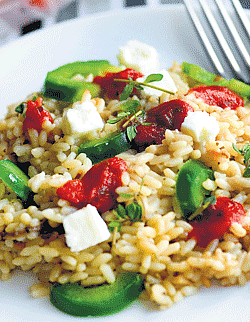
Rice, or to be precise, white rice has been our staple diet over the past several decades. We love it as it cooks faster, is white, fine, fluffy and soft. Little do we realise that white rice gives us little in terms of nutrition besides weight. People in many countries have switched from white rice to brown rice for its positive health benefits.
Brown rice
Brown rice is often referred to as unpolished rice, whole rice or cargo rice and is brownish/red in colour. It retains its outer layer, the stiff cover called the hull or the husk. The rice that has been dehusked or dehulled has a thin brown layer called the bran layer, which is a rich source of bran. White rice is obtained when brown rice is thoroughly polished, removing all the nutrients that reside within the bran layer.
Health benefits
Apart from being a whole grain, it provides complex carbohydrates, which is said to control blood sugar levels.
* It is fibre-rich and has easily digestible starches which can lower cholesterol levels.
* It is rich in minerals and provides nutrients beneficial in the growth of hair, teeth, nails, muscles and bones.
*Its fibre binds to the cancer-causing chemicals and keeps them away from the cells lining the colon, thus protecting the colon against colon cancer.
* It is also beneficial in normalising bowel movement and reduces constipation. nEight eight per cent of the daily value of manganese and 14 per cent of fibre is available in just one cup of brown rice.
* Fermented brown rice has properties which can prevent bladder, liver, oesophageal and blood cancers, according to studies.
Cooking tips
Since brown rice takes much longer than white rice to cook, it is advisable to soak it in the cooker for 30-40 minutes before turning on the heat. Put rice and water in the ratio of 1: 2 (ie: two cups of water for a cup of brown rice). When cooked, this rice will still be firm and nutty. Here are a couple of recipes you could try using brown rice:
Brown Rice Pongal
Ingredients: A cup of brown rice (soaked in water for at least half hour), ¾ cup of moong dal (lightly pan-roasted in a teaspoon of ghee), 1 big onion, 2 green chillies, half a teaspoon each of mustard and jeera, a sprig of curry leaves, 2 tablespoons each of freshly-grated coconut and finely- chopped coriander leaves, ¼ teaspoon of turmeric powder, a teaspoon of whole pepper corns, 2 tablespoons of oil, a tablespoon of ghee (optional), fried cashewnuts and salt to taste.
Method: Heat oil in a cooker and add mustard and jeera. Tip in the curry leaves, finely-sliced onions and chopped green chillies. Saute till onions turn pale and then add the pepper corns. Now, tip in the rice and moong dal. Add four cups of water, grated coconut, chopped coriander leaves, turmeric powder and salt to taste. Cover the cooker and remove from fire after three whistles. Mash well and add half a cup of water if you want the pongal to be slurpy. Serve hot on a plate after drizzling a spoon of ghee.
Garnish with fried cashewnuts and fresh coriander leaves. Tastes great with green chutney.
Brown Rice Dosa
Ingredients: 2½ cups of brown rice, half a cup of urad dal, 1 tablespoon of fenugreek seeds (methi seeds), a quarter cup of beaten rice (avalakki/ poha), a quarter teaspoon of soda bi-carbonate and a tablespoon of salt with a pinch of hing.
Method: Soak the first four ingredients for at least four hours and grind to a batter of dosa consistency. Add salt, soda bi-carb and hing, mix well and rest the batter for about six hours or overnight (if ground in the night) to ferment. Make thick dosas with the batter the next morning. The dosas will have a pink tinge because of the brown rice and taste really good with spicy coconut chutney.
Tips: Brown rice that is available in the market could be fully unpolished or partially unpolished. It has the potential to become rancid because the natural oils in the rice have not been extracted. Always check the ‘use by date’ when buying brown rice.
